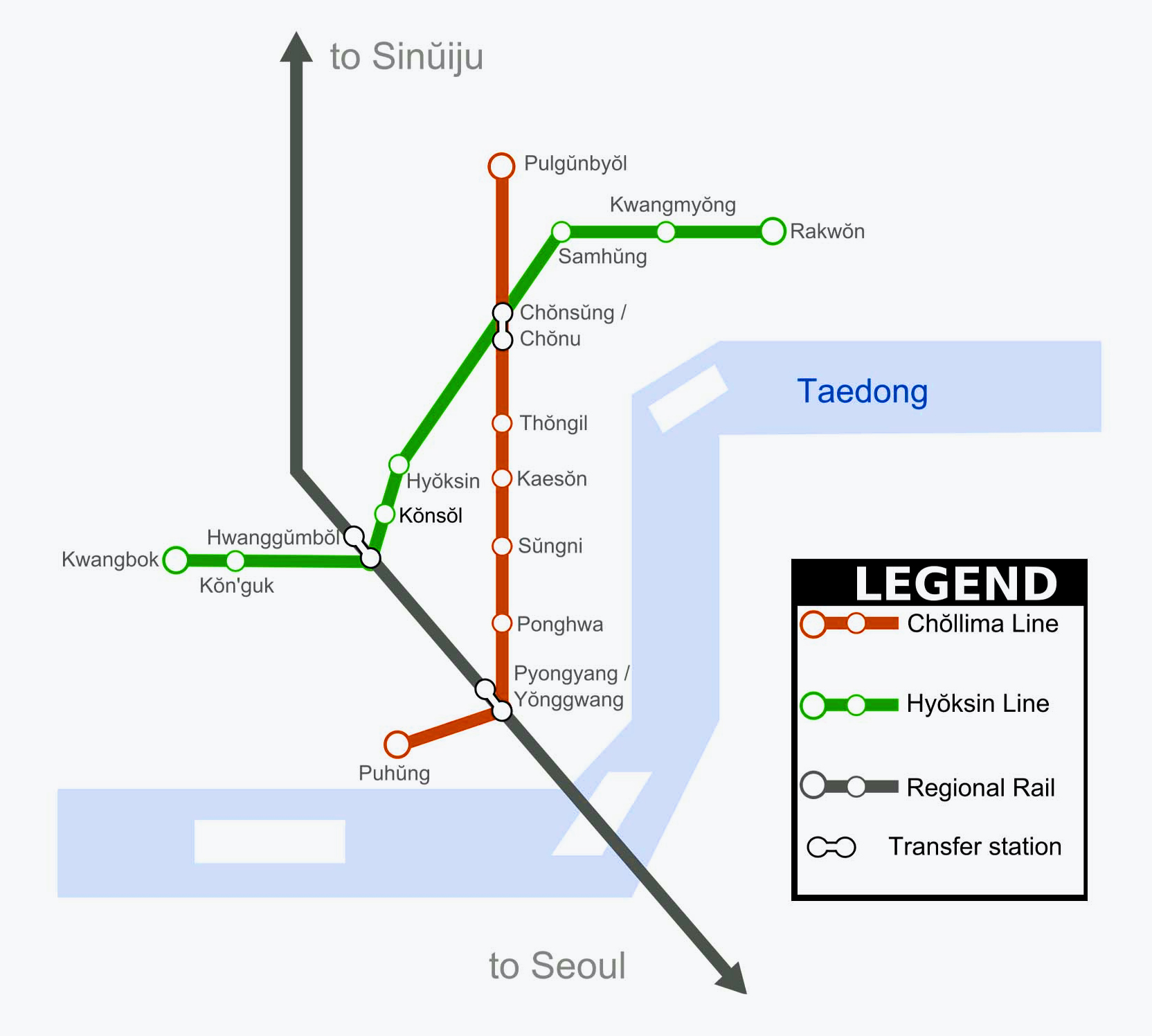Pyongyang Metro Information
The capital city of North Korea, Pyongyang, is served by 2 metro lines under the name of Pyongyang Metro, which is operated by the city’s Transport and Communications Commission. The metro has been in operation since 1973, almost 43 years ago. Divided into 2 separate lines, the metro system serves a total number of 16 sixteen stations. Chollima Line and Hyoksin Line are the names of the 2 respective lines. The metro is an attraction in itself, with an entire museum dedicated to its history. As a testament to this, it has a daily ridership of nearly 100,000 (2009).
The Pyongyang metro serves as the city’s main transport system and carries 700,000 passengers daily. However, it does not provide 24-hour service and operates from 5:00am to 1:00am (M-D).
Unfortunately, the Metro does not provide air conditioning or allow passengers to walk between platforms. There are also no driverless trains and no screen doors on the platforms.
Despite these limitations, the fare is incredibly low at 5 North Korean won. The entire operation is managed by the Transport and Communications Commission.
Pyongyang Metro Map
Map of Pyongyang Metro showing different lines and stations. Click on the map to enlarge it or download the Pyongyang Metro map in PDF format.
Operating Hours
Underground trains usually run every 5 to 7 minutes. During peak hours, trains arrive every 2 minutes. Normal operating hours are from 05:30 to 23:30. However, it is important to note that the entire system is closed on the first Monday of every month and on certain other occasions.
Lines and Stations
The Pyongyang Metro currently operates two lines: the Chollima Line and the Hyoksin Line, which run under the city’s main streets with depots at ground level.
The stations are named after popular figures and themes from North Korea’s revolutionary war. The stations, which are quite far apart from each other, with an average distance of 1500m, are decorated with statues of war heroes, murals, marble, light fixtures and paintings.
The stations were designed to function as bomb shelters in times of war. It is also speculated that military bases are connected to these stations by secret lines.
Chollima Line
In operation since 1973, this line connects the north and south of the city. Starting from Puhŭng station in the south, it passes through six stations along the Taedong River and ends at Pulgŭnbyŏl station in the north.
This line is 12 km long, including a transfer option at Chŏnu station. The stations on this line are Pulgŭnbyŏl, Chŏnu(Chŏnsŭng), Kaesŏn, T’ongil, Sŭngni, Ponghwa, Yŏnggwang, Puhŭng.
Hyoksin Line
This line, in full operation since 1978, connects Kwangbok station in the southwest of the city with Ragwŏn station in the northeast. There are nine stations on the line, but trains do not stop at Kwangmyŏng station.
The total length of the line is 15 km and there is a transfer to the Chollima line at Chŏnu station. The stations on this line are Ragwŏn, Kwangmyŏng, Samhŭng, Chŏnsŭng(Chŏnu), Hyŏksin, Kŏnsŏl, Hwanggŭmbŏl, Kŏn’guk, Kwangbok.
Future Expansion
There are plans to extend the two existing lines in the near future. On the Chollima line, Sŏp’o and Ryŏnmot stations will be added to the north and Ch’ŏngch’un and Mangyongdae stations to the south. On the Hyoksin line, two additional stations, Yŏngung and Ch’ilgok, will be added after Kwangbok.
There are also long-term plans for an additional north-south line that will cross the Taedong River on a bridge. This will create a triangle where the three lines meet in the city centre.
Fare and Tickets
Travelling on the Pyongyang metro is quite affordable, with each ticket costing 5 won, or about UD$0.03.
Tickets used to be aluminium tokens with the metro’s logo on them. Now the metro has introduced paper tickets with the Korean character 지 printed on them. These tickets must be scanned at entry points before passengers can enter the main station area.
Facilities and Services
The Metro Authority provides a number of facilities to ensure a pleasant journey for daily commuters and occasional foreign travellers. These include
- A museum showing the history and gradual development of the Pyongyang Metro.
- Free toilets at stations.
- Passengers can listen to state radio broadcasts and read local newspapers while waiting at the stations.
Rules and Regulations
To ensure a pleasant travelling experience for everyone, passengers must observe certain rules and etiquette in stations and on trains.
- Eating, drinking, smoking, etc. is not allowed on the metro, and violators may be fined.
- Passengers must respect the barriers at the entrance gates.
- Once on the train, passengers should ensure that neither they nor their belongings are sticking out of the train.
Travel Tips
If you are using the metro for the first time, you may find the following tips useful:
- If you are a foreign traveller, make sure you have the necessary permits before getting on or taking photographs at any station.
- Most stations have adjacent bus and taxi services. Plan your journey accordingly to save time.
